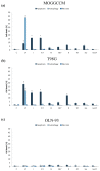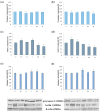Furanocoumarins as Enhancers of Antitumor Potential of Sorafenib and LY294002 toward Human Glioma Cells In Vitro
- PMID: 38255833
- PMCID: PMC10815922
- DOI: 10.3390/ijms25020759
Furanocoumarins as Enhancers of Antitumor Potential of Sorafenib and LY294002 toward Human Glioma Cells In Vitro
Abstract
Furanocoumarins are naturally occurring compounds in the plant world, characterized by low molecular weight, simple chemical structure, and high solubility in most organic solvents. Additionally, they have a broad spectrum of activity, and their properties depend on the location and type of attached substituents. Therefore, the aim of our study was to investigate the anticancer activity of furanocoumarins (imperatorin, isoimperatorin, bergapten, and xanthotoxin) in relation to human glioblastoma multiforme (T98G) and anaplastic astrocytoma (MOGGCCM) cell lines. The tested compounds were used for the first time in combination with LY294002 (PI3K inhibitor) and sorafenib (Raf inhibitor). Apoptosis, autophagy, and necrosis were identified microscopically after straining with Hoechst 33342, acridine orange, and propidium iodide, respectively. The levels of caspase 3 and Beclin 1 were estimated by immunoblotting and for the blocking of Raf and PI3K kinases, the transfection with specific siRNA was used. The scratch test was used to assess the migration potential of glioma cells. Our studies showed that the anticancer activity of furanocoumarins strictly depended on the presence, type, and location of substituents. The obtained results suggest that achieving higher pro-apoptotic activity is determined by the presence of an isoprenyl moiety at the C8 position of the coumarin skeleton. In both anaplastic astrocytoma and glioblastoma, imperatorin was the most effective in induction apoptosis. Furthermore, the usage of imperatorin, alone and in combination with sorafenib or LY294002, decreased the migratory potential of MOGGCCM and T98G cells.
Keywords: LY294002; apoptosis; bergapten; furanocoumarins; gliomas; imperatorin; isoimperatorin; programmed cell death; sorafenib; xanthotoxin.
Conflict of interest statement
The authors declare no conflicts of interest.
Figures










References
-
- Brito C., Azevedo A., Esteves S., Marques A.R., Martins C., Costa I., Mafra M., Bravo Marques J.M., Roque L., Pojo M. Clinical insights gained by refining the 2016 WHO classification of diffuse gliomas with: EGFR amplification, TERT mutations, PTEN deletion and MGMT methylation. BMC Cancer. 2019;19:1–14. doi: 10.1186/s12885-019-6177-0. - DOI - PMC - PubMed
MeSH terms
Substances
LinkOut - more resources
Full Text Sources
Research Materials
Miscellaneous

